Content for TS 23.283 Word version: 19.1.0
1…
10…
10.2…
10.3…
10.3.2
10.3.3…
10.3.4…
10.3.5…
10.3.6…
10.3.7…
10.3.8…
10.4…
10.5…
10.6…
10.6.2…
10.6.3…
10.7…
10.8…
10.11…
10.12…
10.14…
10.15…
10.17…
10.3.4 Group broadcast
10.3.4.1 General
10.3.4.2 Group-broadcast group call procedure with an interworking group where the group-broadcast group is defined in the MCPTT system
10.3.4.3 Group-broadcast group call procedure with an interworking group where the group-broadcast group is defined in the LMR system
10.3.4.4 Group-broadcast group call release with an interworking group procedure where the group-broadcast group is defined in the MCPTT system
10.3.4.5 Group-broadcast group call release with an interworking group procedure where the group-broadcast group is defined in the LMR system
10.3.4.6 Broadcast group regroup call using pre-configured group
10.3.4.6.1 General
10.3.4.6.2 Broadcast group regroup call using pre-configured group the MCPTT system
10.3.4.6.3 Broadcast group regroup call using pre-configured group in the IWF
...
...
10.3.4 Group broadcast p. 53
10.3.4.1 General p. 53
A broadcast group call is a special group call where the initiating user expects no response from the receiving users so that when the transmission is complete, so is the call. The initiating user can be an MCPTT user or can be an LMR user.
The group-broadcast group is defined as a set of groups, not a set of users. The user that originates the group-broadcast group call is the only one transmitting media during this call.
The group-broadcast group is defined with a hierarchy. For example, groups A and B may be subordinate to a group-broadcast group. All subordinate groups belonging to a group-broadcast group are defined either in the MCPTT system or the LMR system.
10.3.4.2 Group-broadcast group call procedure with an interworking group where the group-broadcast group is defined in the MCPTT system p. 53
Subclause 10.6.2.5.2.1 of TS 23.379 describes the procedure for a group-broadcast group call within a single MCPTT system. The present procedure describes a group-broadcast group call that includes the IWF.
In this procedure, the MCPTT server is initiating the broadcast and is the owner of the group-broadcast group.
The procedure shows the case where the call is initiated by a MCPTT user. However, if the override feature is enabled, then the call originator may be overridden.
Figure 10.3.4.2-1 illustrates the procedure for group-broadcast group call establishment (the group-broadcast group is defined in the MCPTT system).
Pre-conditions:
- The group (e.g. A) to which MCPTT client 2 and the IWF are members is a subordinate group of the group-broadcast group (i.e., the group-broadcast group was defined with group A as a subordinate group).
- The group (e.g. A) currently has an on-going MCPTT group call that is not an MCPTT emergency group call.
- The call initiator of the group-broadcast group is a member of another group (e.g., X, not group A) which is also a subordinate group of the group-broadcast group (i.e., the group-broadcast group was defined with group X as a subordinate group).
- The group-broadcast group and its subordinate groups are defined in the same group management server and served by the same MCPTT server.
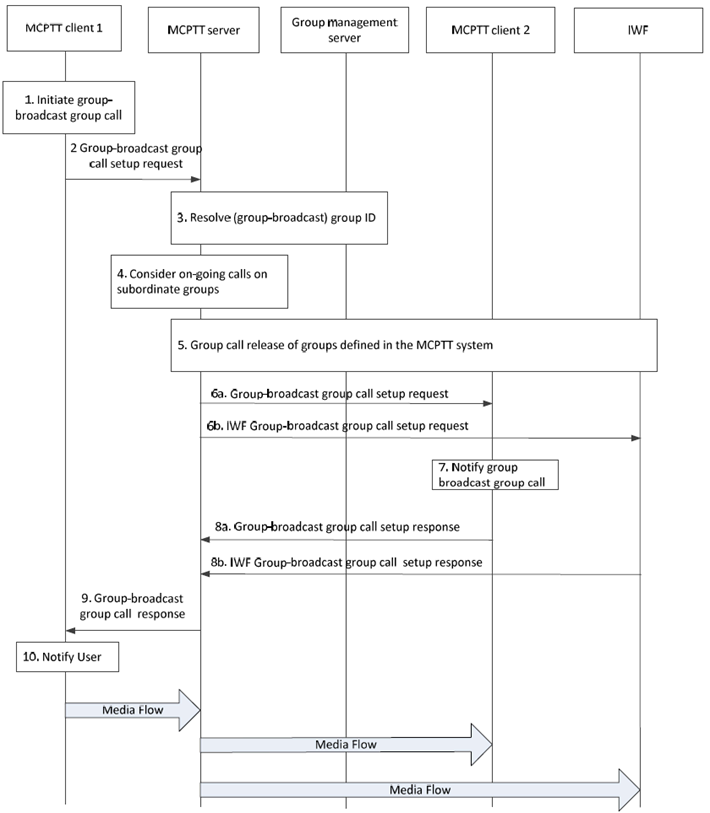
Step 1.
Once the user of MCPTT cleint 1 completes transmitting, the group-broadcast group call is released.
MCPTT user at MCPTT client 1 initiates the group-broadcast group call setup procedure.
Step 2.
The MCPTT client 1 sends a group-broadcast group call request to the MCPTT server.
Step 3.
The MCPTT server needs to resolve the group-broadcast group ID into its subordinate groups in order to contact the affiliated MCPTT users of those subordinate groups.
Step 4.
The MCPTT server then needs to consider any on-going group calls on those subordinate groups because this may affect the behaviour for what happens next. In this case a group call exists on a subordinate group. Thus, the MCPTT users involved in the group call on this subordinate group.
Step 5.
The MCPTT server performs group call release procedures of groups defined in the MCPTT system as described in subclause 10.3.3.8.2.
Step 6.
A group-broadcast group call request is sent to MCPTT client 2 and an IWF group-broadcast group call request to the IWF. If the IWF has affiliated to this group on behalf of the group's LMR users, only one IWF group-broadcast group call request is sent to the IWF. If the MCPTT server has received individual affiliations from the group's LMR users, an individual IWF group-broadcast group call request is sent (to the IWF) for each affiliated LMR user.
Step 7.
MCPTT client 2 is notified of the incoming group-broadcast group call.
Step 8.
MCPTT client 2 and the IWF respond to the IWF group-broadcast group call request by sending an IWF group-broadcast group call response. If the IWF has affiliated to this group on behalf of the group's LMR users, only one IWF group-broadcast group call response is sent to the MCPTT server. If the MCPTT server has received individual affiliations from the group's LMR users, an individual IWF group-broadcast group call response is sent (to the MCPTT server) for each affiliated LMR user.
Step 9.
The MCPTT server responds to MCPTT client 1 (the call initiator) that the group-broadcast group call has been established by sending a group-broadcast group call response.
Step 10.
The MCPTT client 1 notifies its user that the user can begin transmitting using the group-broadcast group call resources.
10.3.4.3 Group-broadcast group call procedure with an interworking group where the group-broadcast group is defined in the LMR system p. 56
Subclause 10.6.2.5.2.1 of TS 23.379 describes the procedure for a group-broadcast group call within a single MCPTT system. The present procedure describes a group-broadcast group call that includes the IWF.
In this procedure, the IWF is the owner of the group-broadcast group and is initiating the group-broadcast group call.
The procedure only shows the case where the call is initiated by a MCPTT user. However, if the override feature is enabled, then the call originator may be overridden.
Figure 10.3.4.3-1 illustrates the procedure for group-broadcast group call establishment (the group-broadcast group is defined in the LMR system).
Pre-conditions:
- The group (e.g. A) to which MCPTT client 2 is a member is a subordinate group of the group-broadcast group (i.e., the group-broadcast group was defined with group A as a subordinate group).
- The group (e.g. A) currently has an on-going MCPTT group call that is not an MCPTT emergency group call.
- The call initiator, MCPTT client 1, of the group-broadcast group is a member of another group (e.g., X, not group A) which is also a subordinate group of the group-broadcast group (i.e., the group-broadcast group was defined with group X as a subordinate group).
- The group-broadcast group and its subordinate groups are defined in the IWF.
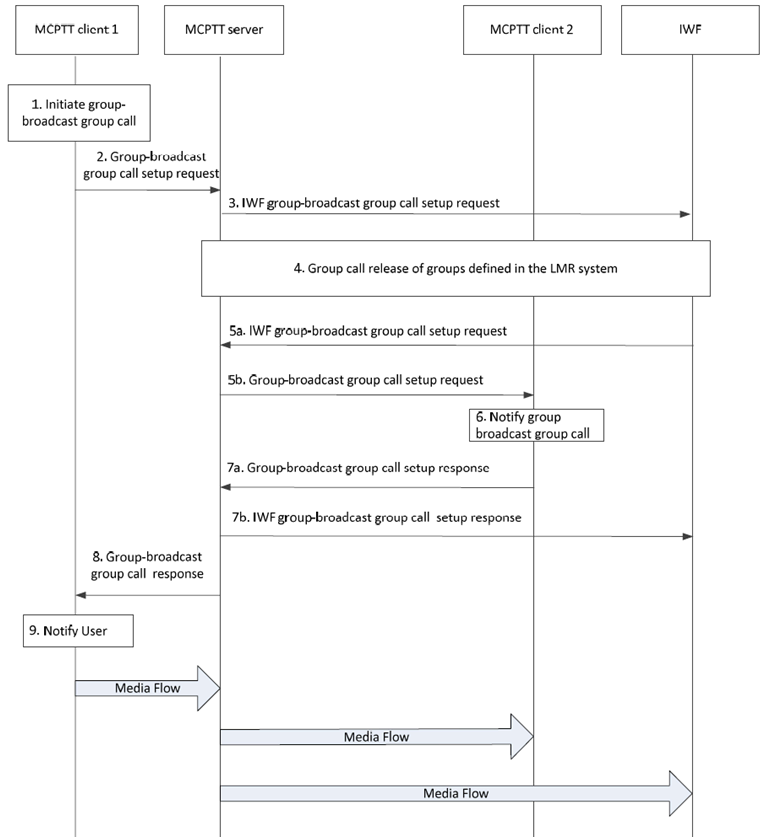
Step 1.
Once the user of MCPTT client 1 completes transmitting, the group-broadcast group call is released.
MCPTT user at MCPTT client 1 initiates the group-broadcast group call setup procedure.
Step 2.
The MCPTT client 1 sends a group-broadcast group call request to the MCPTT server.
Step 3.
As the group-broadcast group is defined in the LMR system the MCPTT server sends an IWF group-broadcast group call setup request to the IWF.
Step 4.
The IWF performs group call release procedures of groups defined in the LMR system as described in subclause 10.3.3.8.3.
Step 5.
The IWF issues a group-broadcast group call setup request to establish the group-broadcast call.
Step 6.
The MCPTT user of MCPTT client 2 is notified.
Step 7.
Optionally, MCPTT client 2 respond with a group-broadcast group call response to the MCPTT server and then to the IWF.
Step 8.
The MCPTT server responds to MCPTT client 1 (the call initiator) that the group-broadcast group call has been established by sending a group-broadcast group call response.
Step 9.
The MCPTT client 1 notifies its user that the user can begin transmitting using the group-broadcast group call resources.
10.3.4.4 Group-broadcast group call release with an interworking group procedure where the group-broadcast group is defined in the MCPTT system p. 58
When the call originator has completed transmitting, the group-broadcast group call is ended and the resources are released.
Figure 10.3.4.4-1 illustrates the procedure for group-broadcast group call release (the group-broadcast group is defined in the MCPTT system).
Pre-conditions:
- An on-going group-broadcast group call involving MCPTT client 1, the MCPTT client 2 and the IWF exists.
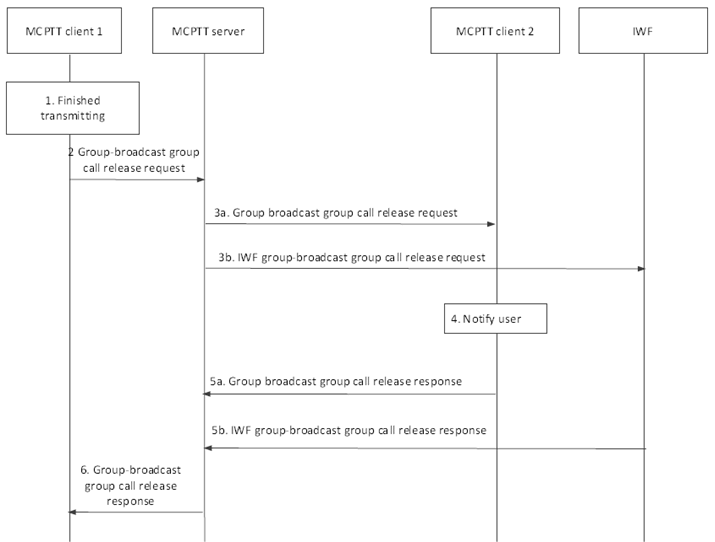
Step 1.
MCPTT user on MCPTT client 1 finished transmitting.
Step 2.
A group-broadcast group call release request is sent to the MCPTT server of the group-broadcast group.
Step 3.
The MCPTT users of MCPTT client 2 and the IWF of the group-broadcast group's subordinate groups are sent a group-broadcast group call release request. If the IWF has affiliated to this group on behalf of the group's LMR users, only one IWF group-broadcast group call release request is sent to the IWF. If the MCPTT server has received individual affiliations from the group's LMR users, an individual IWF group-broadcast group call request is sent (to the IWF) for each affiliated LMR user.
Step 4.
MCPTT client 2 and the IWF notify their users that the group-broadcast group call has ended.
Step 5.
MCPTT client 2 and the IWF respond to confirm the release of the group-broadcast group call by sending a group-broadcast group call release response. If the IWF has affiliated to this group on behalf of the group's LMR users, only one IWF group-broadcast group call release response is sent to the MCPTT server. If the MCPTT server has received individual affiliations from the group's LMR users, an individual IWF group-broadcast group call response is sent (to the MCPTT server) for each affiliated LMR user.
Step 6.
The MCPTT server sends a group-broadcast group call release response indicating to the initiator that the call is now ended.
10.3.4.5 Group-broadcast group call release with an interworking group procedure where the group-broadcast group is defined in the LMR system p. 60
When the call originator has completed transmitting, the group-broadcast group call is ended and the resources are released.
Figure 10.3.4.5-1 illustrates the procedure for group-broadcast group call release (the group-broadcast group defined in the LMR system).
Pre-conditions:
- An on-going group-broadcast group call involving MCPTT client 1, the MCPTT client 2 and the IWF exists.
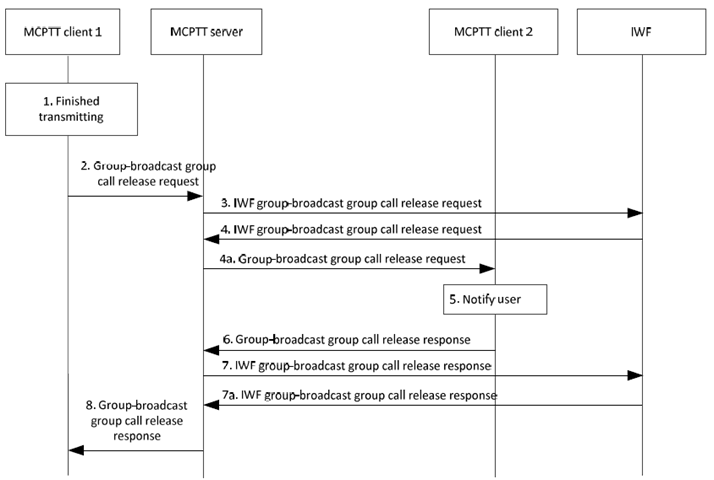
Step 1.
The MCPTT user on MCPTT client 1 finished transmitting.
Step 2.
A group-broadcast group call release request is sent to the MCPTT server.
Step 3.
As the group-broadcast group is defined in the LMR system the MCPTT server sends an IWF group-broadcast group call release request to the IWF.
Step 4.
The IWF sends an IWF group-broadcast group call release request to the MCPTT server hosting client 2. The MCPTT server sends the group-broadcast group call release request to MCPTT client 2.
Step 5.
MCPTT client 2 is notified that the group-broadcast group call has ended.
Step 6.
MCPTT client 2 responds to confirm the release of the group-broadcast group call by sending a group-broadcast group call release response.
Step 7.
The MCPTT server sends an IWF group-broadcast group call release response to the IWF. The IWF becomes aware that MCPTT client 2 has confirmed the group-broadcast group call release and replies with another IWF group-broadcast group call release response back to the MCPTT server to trigger step 8.
Step 8.
The MCPTT server sends a group-broadcast group call release response indicating to the initiator that the group-broadcast group call is now ended.
10.3.4.6 Broadcast group regroup call using pre-configured group |R16| p. 61
10.3.4.6.1 General p. 61
The temporary group created using a pre-configured group can be a broadcast group or a non-broadcast group.
A broadcast group regroup call using pre-configured groups can be achieved by first regrouping users into a pre-configured group regroup, making the broadcast group call on the pre-configured group, and then cancelling the pre-configured group regroup.
10.3.4.6.2 Broadcast group regroup call using pre-configured group the MCPTT system p. 61
The broadcast group regroup call procedure using pre-configured group allows an authorized MCPTT user to initiate a broadcast call to a set of MCPTT groups, which are regrouped only for the duration of the broadcast call. The regroup is cancelled at the end of the broadcast call to prevent users from talking back on the pre-configured group regroup. This procedure requires that the authorized MCPTT user is a group member of at least one of the MCPTT groups included in the regroup operation.
Figure 10.3.4.6.2-1 illustrates the procedure to initiate a broadcast group regroup call using a pre-configured MCPTT regroup group owned by the MCPTT system. For simplicity, no receiving clients are shown.
Pre-conditions:
- The MCPTT client is registered with the MCPTT service.
- The MCPTT group identity and group configuration for the pre-configured group regroup have been pre-configured in the MCPTT client and the IWF. The MCPTT client and the IWF have received the relevant security related information to allow them to communicate in the pre-configured group regroup.
- The MCPTT client is authorized to initiate a pre-configured group regroup using the pre-configured group regroup procedure.
- The MCPTT client is aware of a suitable pre-configured group whose configuration has been pre-configured in the IWF and the MC service UEs of the MCPTT users who will be regrouped.
- The MCPTT client is affiliated to group 1.
- The IWF is affiliated to one or more of MCPTT group 1, 2 or 3.
- The pre-configured group regroup is homed in the MCPTT server.
- The IWF is home to at least one group that's a constituent group of the pre-configured group regroup.
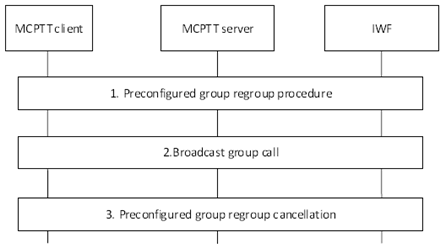
Step 1.
The authorized user of the MCPTT client initiates the pre-configured group regroup formation procedure using pre-configured groups as specified in subclause 10.3.7.1. MCPTT groups 1, 2, and 3 are regrouped into group 4.
Step 2.
The MCPTT user at the MCPTT client performs the broadcast group call procedure as specified in subclause 10.3.4.
Step 3.
The MCPTT client initiates the pre-configured group regroup cancellation procedure using pre-configured groups as specified in subclause 10.3.7.1.
10.3.4.6.3 Broadcast group regroup call using pre-configured group in the IWF p. 62
The broadcast group regroup call procedure using a pre-configured group allows an IWF user to initiate a broadcast call to a set of MCPTT groups, which are regrouped only for the duration of the broadcast call.
Figure 10.3.4.6.3-1 illustrates the procedure to initiate a broadcast group regroup call using a pre-configured group owned by the IWF.
Pre-conditions:
- MCPTT clients 1 and 2 are registered with the MCPTT service.
- The MCPTT group identity and group configuration for the pre-configured group regroup have been pre-configured in MCPTT clients 1 and 2, and MCPTT clients 1 and 2 have received the relevant security related information to allow them to communicate in the pre-configured group regroup.
- MCPTT client 1 is affiliated to group 1, MCPTT client 2 is affiliated to group 2. Group 3 is used as the pre-configured group regroup.
- The pre-configured group regroup is homed in the IWF.
- The MCPTT server is home to at least one group that's a constituent group of the pre-configured group regroup.
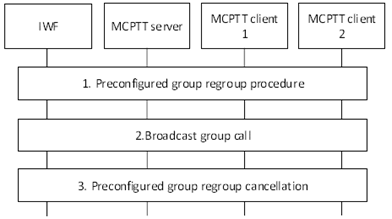
Step 1.
The IWF initiates the group regroup formation procedure using pre-configured groups as specified in subclause 10.3.7.1. MCPTT groups 1 and 2 are regrouped into group 3.
Step 2.
The IWF performs the broadcast group call procedure as specified in subclause 10.3.4.
Step 3.
The IWF initiates the pre-configured group regroup cancellation procedure using pre-configured groups as specified in subclause 10.3.7.1.